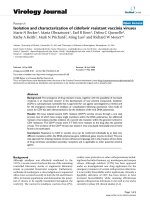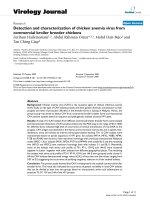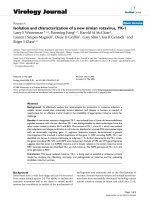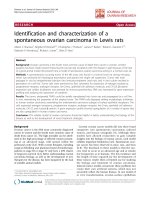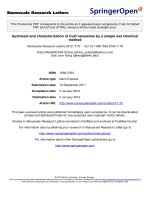Báo cáo hóa học: "Synthesis and characterization of VO2-based thermochromic thin films for energy-efficient windows" pdf
Bạn đang xem bản rút gọn của tài liệu. Xem và tải ngay bản đầy đủ của tài liệu tại đây (1009.27 KB, 7 trang )
NANO EXPRESS Open Access
Synthesis and characterization of VO
2
-based
thermochromic thin films for energy-efficient
windows
Carlos Batista
*
, Ricardo M Ribeiro and Vasco Teixeira
Abstract
Thermochromic VO
2
thin films have successfully been grown on SiO
2
-coated float glass by reactive DC and pulsed-
DC magnetron sputtering. The influence of substitutional doping of V by higher valence cations, such as W, Mo,
and Nb, and respective contents on the crystal structure of VO
2
is evaluated. Moreover, the effectiveness of each
dopant element on the reduction of the intrinsic transition temperature and infrared modulation efficiency of VO
2
is discussed. In summary, all the dopant elements–regardless of the concentration, within the studied range–
formed a solid solution with VO
2
, which was the only compound observed by X-ray diffractometry. Nb showed a
clear detrimental effect on the crystal structure of VO
2
. The undoped films presented a marked thermochromic
behavior, specially the one prepared by pulsed-DC sputtering. The dopants effectively decreased the transition of
VO
2
to the proximity of room temperature. However, the IR modulation efficiency is markedly affected as a
consequence of the increased metallic character of the semiconducting phase. Tungsten proved to be the most
effective element on the reduction of the semiconducting-metal transition temperature, while Mo and Nb showed
similar results with the latter being detrimental to the thermochromism.
Introduction
Solar control coatings are a technology of growing interest
due to the necessity of improving the energy efficiency of
buildings, with a view to avoiding excessive energy con-
sumption due to cooling systems during summer. The lat-
est approach is based on the use of thermochromic
coatings on the so-c alled smart w indows. These coatings
possess the ability of actively changing their optical prop-
erties as a consequence of a reversible structural transfor-
mation when going through a critical temperature.
Vanadium dioxide is an example of a thermochromic
materia l whic h is a promising candidate for this kind of
application as proposed by Granqvist [1]. The change
on its optical and also electrical properties takes place at
approximately 68°C as a result of a first-order structural
transition, going from a monoclinic to a tetragonal
phase upon heating [2,3]. The atomic displacements
driven by the structural transition are accompanied by a
redistribution of the electronic charge in the crystal
lattice, which in turn changes the nature of the intera-
tomic bonding [4]. The low-temperature semiconduct-
ing phase which is transparent to radiation in the visible
and infrared spectral ranges maximizes the heating
because of blackbody radiation, while the metallic high-
temperature phase filters the infrared radiation and
maintains at the same time t he transparency required,
in the visible range, to maintain an environment of
natural light. In order to achieve a reasonable transpar-
ency (transmittance, 40-60%) in the visible range and at
the same time a n acceptable IR modulation efficiency,
the VO
2
films must not exceed thicknesses in the order
of 100-150 nm [5], and combined with anti-reflection
coatings, the transparency can be further improved
[6,7]. To obtain window coatings with controlled thick-
nesses in the nanometer range, atomistic processes such
as magnetron sputtering are well suited to fulfill the
condition. A semiconductor-metal transition tempera-
ture of 68°C is too high for this application and must
therefore be reduced. At present, there are two
approaches to reduce the transition temperature, the
substitutio n of part of the vanadium cations by other
metals such as tungsten [8-14], m olybdenum [15-18], or
* Correspondence:
Department of Physics, University of Minho, Campus de Gualtar, 4710-057
Braga, Portugal
Batista et al. Nanoscale Research Letters 2011, 6:301
/>© 2011 Batista et al; licensee Springer. This is an Open A ccess article distributed under the terms of the Creative Commons Attribution
License ( which permits unrestricted use, distributi on, and reproduction in any medium,
provided the original work is properly cited.
niobium [16,19,20], or the substitution of part of the
oxygen anions by other elements, e.g., fluorine [21].
In this study, we compare magnetron-sputtered VO
2
thin films prepared with different doping elements s uch
as W, Mo, and Nb and different doping concentrations.
We report on the influence of each el ement and respec-
tive concentrations on the crystal struct ure of the films,
optical/thermochromic performance and eff ectiven ess
on the reduction of the semiconductor-metal transition
from 68°C to room temperature, envisaging the applica-
tion on energy-efficient windows.
Experimental details
The vanadium dioxide f ilms were reactively deposited
onto SiO
2
-coated float glass substrates by DC and
pulsed-DC magnetron sputtering from a h igh purity
(99.95%) metallic vanadium target in a given oxygen/
argon atmosphere. Before the deposition, the vacuum
chamber was evacuated down to a pressure of about 3 ×
10
-5
mbar. A pre-sputtering of the metal target was car-
ried out before each deposition during 10 min, in the
same conditions as for film preparation, but in an
oxygen-free atmosphere. This procedure ensures an
oxide-free metallic surface for each deposition. For the
deposition of the films, both oxygen and argon were
introduced into the chamber separately through two gas
mass flow controllers. The deposition parameters chosen
to deposit the three sets of films are summarized in
Table1.Thedopingofthefilmswasdonebyplacinga
number of high-purity dopant m etal pieces in a con-
centric positioning over the round vanadium target so
that both elements c ould be co-sputtered allowing a
homogeneous dispersion of the dopant elements in the
film. In order to obtain films with different dopant con-
centrations, the number of dopant pieces has been
either varied or moved along the target surface.
The actual doping concentration in the films has been
determined by X-ray photoelectron spectroscopy which
permitted to assess the elemental composition of the
films. The structural characterization has been done
by X-ray diffracto metry (XRD) using a X-ray diffract-
ometer operating with a continuous scan of Cu K
a1
radiation with l = 1.54056 Å. The optical/thermochro-
mic behavior has been evaluated in an optical spectro-
photometer (Shimadzu UV-3101PC) with an embedded
sample heating-cooling cell. It has been done by
measuring the spectral normal transmittance at the UV-
Vis-near-infrared (NIR) range, from 250 to 2500 nm,
under and above the transition temperature. The deter-
mination of the transit ion temperature was carried out
by evaluating the optical transmittance change with
temperature a t a given NIR wavelength, in this case at
l = 2500 nm. The transition temperatures were then
estimated by determining the first derivative of both
curves of the hysteresis loops (heating and cooling) and
considering the mean value.
Results and discussion
Structural characterization
The crystal structure of the three sets of films has been
assessed by XRD, and the obtained diffraction spectra are
shown in Figure 1. The XRD patterns show t he range
where the most significant reflection peaks of VO
2
appear. The poor signal intensities of the crystallite-
reflected plane directions are due to the nanocrystallinity
and small thicknesse s of the fil ms which are estimated to
be around 125 nm, for the chosen processing conditions
[5]. Despite the broad sho ulder f ound with in 15-40°
which is due t o the contribution of the amorphous
volume of glass substrate, all patterns can be indexed to
single-phase VO
2
(M) which holds a monoclinic structure
[22]. No reflections were observed attributable to other
vanadium oxides or to compounds deriving from the
dopant elements, which suggests that a solid solution of
vanadium dioxide with dopant homogeneously dispersed
is formed. It can be seen in Figure 1a that for the given
processing parameters, pure vanadium dioxide reveals a
structure preferably oriented in the (002) plane direction,
as observed by the peak at 2θ = 39.6°, although some
traces of (011) reflection are detectable at 2θ = 27.8°.
With addition of tungsten to a certain extent, as seen in
pattern (2) for film V
0.97
W
0.03
O
2
, the same preferential
crystal orientation is maintained. The fi lm with the high-
est W content, V
0.95
W
0.05
O
2
, reveals an evident polycrys-
talline structure in which the (011) plane direction
becomes the dominating crystal orientation. This in di-
cates the exist ence of a critical level of W contents in the
VO
2
solid solution above which the structure becomes
more stably o riented along the (011) direction. All the
Mo-doped films reveal preferential crystal orientation
along the (002) direction for all films regardless of the
Mo-doping level, although some traces of crystallites
oriented along the (011) and (21-1) directions are b arely
Table 1 Processing conditions used for depositing the
VO
2
films
W- and Mo-doped films Nb-doped films
Base pressure (mbar) 3 × 10
-5
3×10
-5
Work pressure (mbar) 4 × 10
-3
1×10
-3
Oxygen/argon ratio (%) 14.3 50
Total gas flow (sccm) 19.2 6
DC current (A) 0.5 -
Pulsed-DC current (A) - 0.58
Frequency (kHz) - 10
Reverse time (μs) - 5
Substrate temperature (°C) 450 450
Deposition time (min) 5 3
Batista et al. Nanoscale Research Letters 2011, 6:301
/>Page 2 of 7
noticeable at 2θ = 27.8° and 37.0°, respectively. In sum-
mary, no significant differences on the crystal structure
can be observed in the films with different Mo contents.
This is in agreement with results reported f or Mo-doped
VO
2
on single crystal sapphire substrates prepared by
pulsed laser deposition [23] and RF-sputtered Mo-doped
VO
2
[17] although the latter presents strong (011) pr e-
ferred orientation. With regard to the VO
2
films prepared
by pulsed-DC sputtering, shown in Figure 1c, the main
crystal orientation is again along the (002) direction
although the (011) is also noticeable in some of the films.
Comparing the patterns among the different Nb contents
in the region of the (002) diffraction peak, as seen in the
inset, a shifting of the peak to lower angles accompanied
by a broadening is observed as the Nb at.% in the film is
increased. X-ray diffraction peaks broaden either when
crystallites become smaller or if lattice defects such as
microstresses, stress gradients, and/or chemical heteroge-
neities are presen t in large enough abundance [24]. Peak
shift is related to different types of internal stresses and
planar faults in the crystal lattice, especially stacking
faults or twin boundaries. In this particular case, the peak
shifts toward lower diffraction angles, implying an
increase of interplanar spacing after Nb doping. These
changes on the (002) diffraction peak parameters have
not been observed in our previous studies for tungsten
[14], molybdenum [18,25], and Indium [25] as dopants
in VO
2
.
Optical analyses
The optical properties of the films have been studied by
optical spectrophotometry in the UV-Vis-NIR range,
and the obtained results areshowninFigure2.Onthe
left is shown the optical transmittance as a function of
wavelength, and on the r ight is shown the optical trans-
mittance at l = 2500 nm as a function of temperature.
It can be seen in Figure 2a1 that maximum luminous
transmittances of about 30-40% are associated with a
sharp thermochromic switch behavior at the NIR spec-
tral range that is reduc ed by increa sing W doping con-
centrations. The differences regarding the maximum
luminous transmittances are mainly due to slight varia-
tions in thickness from film to film and not due to a
signi ficant influence of tungsten, which i s in accordance
with that observed by Burkhardt et al. [8]. Wi th increas-
ing W doping concentration up to 5%, the IR modula-
tion efficiency (T
s
-T
m
) reduced from 35%, for the
undoped film down to 23%. Moreover, a slight loss can
be observed in the luminous transparency when switch-
ing from a semiconducting to a metallic state, which is
common in all the films reg ardless of the dopant ele-
ment and concentration. The Mo-doped films showed
maximum optical transmittances in the visible range
from 35 to 45% and decreased IR modulation efficiency
from 36 to 25% with increasing substitutional Mo c on-
tent from 3 to 11%. The infrared modulation efficiency
of th e pure VO
2
film prepared by pulsed-DC sputtering,
Figure 1 XRD spectra of VO
2
films deposited by (a1- a3, b4-b6) DC and (c7-c10) pulsed-DC sputtering, doped with different dopant
element and contents: (a1) pure VO
2
, (a2) V
0.97
W
0.03
O
2
, and (a3) V
0.95
W
0.05
O
2
; (b4) V
0.97
Mo
0.03
O
2
, (b5) V
0.94
Mo
0.06
O
2
, and (b6) V
0.89
Mo
0.11
O
2
; (c7)
pure VO
2
, (c8) V
0.96
Nb
0.04
O
2
, (c9) V
0.93
Nb
0.07
O
2
, and (c10) V
0.89
Nb
0.11
O
2
.
Batista et al. Nanoscale Research Letters 2011, 6:301
/>Page 3 of 7
shown in Figure 2a3 was found to be higher than that of
VO
2
prepared by conventional DC sputtering, as seen in
Figure 2a1. The use of an asymmetric-bipolar, pulsed
DC power supply allows higher sputtering yields by per-
iodically reversing the electrode voltage, thereby
neutralizing charge build-up on the target surface during
poisoning in the r eactive process. In addition, i t also
reduced the working gas pressure and increased the ion
current density. All these factors contribute to a higher
ion bombardment during film growth which contributes
Figure 2 Optical transmittance spectra of VO
2
films: (a1-a3) optical transmittance as a function of wavelength, in semiconducting and
metallic states; (b1-b3) optical transmittance as a function of temperature obtained at l = 2500 nm.
Batista et al. Nanoscale Research Letters 2011, 6:301
/>Page 4 of 7
to an improved film density/crystallinity and enhance-
ment of its properties. The IR modulation efficiency is
again affected by the Nb contents in the film, and a
marked drop is obvious for Nb over 4 at .%. Above this
Nb content, the material starts revealing a very pro-
nounced metal-like character, as demonstrated by
the decrease of transparency to IR light of the low-
temperature phase. Moreover, the maximum luminous
transmittance is a round 40%, for pure VO
2
,andpro-
gressively decreases down to 22% with the increase of
substitutional Nb up to 11 at.% in the VO
2
solid solu-
tion. The decrease in the IR modulation efficiency
resulting from doping is mainly due to decrease in the
transmittance in the semiconducting state. This decrease
is explained by the enhancement of the carrier concen-
tration due to the presence of dopant ion donors [21,26]
which also lowers the resistivity of the films [26]. The
doping of VO
2
increased the electron density in the
film, which caused the Fermi energy level shift toward
the conduction band. Since intrinsic VO
2
thin film is of
n-type, introduction of ion donors c ause an inevitable
degradation of the transmittance (and resistivity) of the
semiconducting low-temperature phase. Likewise, it is
expected that the enhancement of the carrier concentra-
tion would also lower the transmittance at the infrared
in the metallic state, which indeed does so in the case of
the Nb-doped films, as seen in Figure 2a3. However,
W- and Mo-doped f ilms do not show the same trend.
Although we were not able to effectively determine crys-
tallite sizes because of poor peak statistics of XRD
patterns for the diffe rent doped films, it has been shown
that doping reduces the c rystallite size [27,28]. There-
fore, the number of crystallites as well as boundaries
volume will increase and contribute to trap charge
carriers which will result in loss of the metallic behavior.
We speculate that in case of W- and Mo-doped films,
this effect could be more marked t han that of increase
in carrier concentration due to W and Mo donors. Sub-
stitution of V
4+
by higher valence cations, such as Nb
5+
,
W
6+
,andMo
6+
, give rise to t he same V
1-x
M
x
O
2
system
[2]. According to studies conducted by Tang e t al. [29],
each added W ion breaks up a V
4+
-V
4+
homopolar
bond and causes the transfer of two 3d electrons to the
nearest V ions for charge compensation, forming two
new bonds, V
3+
-W
6+
and V
3+
-V
4+
. The loss of homopo-
lar V
4+
-V
4+
bonding destabilizes the semiconducting
phase and lowers the metal-semiconductor transition
temperature. As regards W doping, Mo acts in the same
way o n the reduction of phase transition temper ature,
i.e., introducing extra electrons in the d bands of vana-
dium which induce a charge transfer from Mo to V [2].
In the case Nb, according to Magariño et al. [20], the
Nb
4+
ion substitutes the V
4+
ion in the V
4+
-V
4+
bonding
and due to charge transfer a V
3+
-Nb
5+
bond is formed.
As observed in Figure 2b1,b2,b3, the semiconductor-
metal phase transition exhibits a characteristic thermal
hysteresis which is due to latent heat evolved and
absorbed during the first-order structural transition [17].
The shifting of the hysteresis loops to lower tempera-
tures as a c onsequence of the increasing contents of
substitutional W in the VO
2
solid solution is very clearly
seen. The resulting transition temperatures determined
from the optical transmittance hysteresis loops were
adjusted from 63 to 28°C. The addition of Mo or Nb to
VO
2
also affects the hysteresis loo ps which are also
shifted to lower temperatures as the doping concentra-
tion increases. Transition temperatures as low as 32 and
34°C were achieved for Mo-doped and Nb-doped films,
respectively. The transition temperature (T
t
) obtained
for the pure VO
2
film prepared by pulsed-DC sputtering
was 59°C, which is lower than that obtained for VO
2
prepared by DC sputtering, i.e., 63°C. It is known that
the transition temperature of pure VO
2
in thin film
form may present reduced values depending on pr oper -
ties, such as stresses, thickness, stoichiometry, structure,
grain size, etc. [9,15], which are directly associated to
the chosen processing conditions. Pure V O
2
shows a
clear transition region with well- defined semiconducting
and metal domains. The doped V
0.96
Nb
0.04
O
2
film
shows a similar hysteresis loop shape but with a clear
shift to lower temperatures without any significant loss
in the transmission in the semiconducting state. For
higher Nb concentrations, there is an obvious degrada-
tion of the hysteresis which causes the ambiguous
boundaries of the transition The estimated transition
temperatures in these cases are not in fa ct a result of a
real reduction in the temperature, which would be given
by a shift of the hysteresis, but rather in a reduction of
Figure 3 Relationship between the dopant contents in the film
and the resultant semiconductor-metal phase transition
temperature.
Batista et al. Nanoscale Research Letters 2011, 6:301
/>Page 5 of 7
the slope of the transition. In all cases a reduction of the
hysteresis width is also observable, which is assumed to
result from the reduction in the size of the crystallite
distribution with doping [17,21].
The effectiveness of each dopant on the r eduction of
the semiconducting-metal transition temperature in
VO
2
is compared in Figure 3. All the three elements
showed a linear decrease of the transition temperature
with the increase in the concentration of substitutional
doping element. Tungsten is clearly the mo st effective
dopant element showing a decrease of about 7°C per at.
%.MoandNbshowednearlythesameresults,about3
and 2°C, per at % Mo and Nb, respectively.
Conclusions
Thermochromic VO
2
thin films were successfully
synthesized by DC and pulsed-DC reactive magnetron
sputteri ng. Different dopant elemen ts, such as tungsten,
molybdenum, and niobium, with different doping con-
centrations were introduced in the VO
2
solid solution
during the film g rowing by co-sputtering the res pective
metal dopants, and Vanadium in a reactive O
2
/Ar atmo-
sphere. XRD re sults showed single phase VO
2
(M) for all
the f ilms regardless of dopant element and concentra-
tion. The dopants effectively decreased the transition
temperature of VO
2
whereas the thermochromism of
the films was markedly affected, especially that in the
Nb-dope d ones. Nb causes significant amount of defects
in the crystal lattice which clearly degrade the optical
properties while reducing the semiconductor-metal tran-
sition to room temperature.
Abbreviations
XRD: x-ray diffractometry.
Acknowledgements
Part of this study was financially supported by the research project
“Termoglaze–Production of thermochromic glazings for energy saving
applications”–FP6-017761, funded by the European Commission. Carlos
Batista gratefully thanks the Portuguese Foundation for Science and
Technology–FCT for the PhD grant with reference SFRH/BD/40512/2007.
Authors’ contributions
CB designed the study, carried out the experimental work and draft the
manuscript. RR and VT coordinated the study. All authors read and approved
the final manuscript.
Competing interests
The authors declare that they have no competing interests.
Received: 5 November 2010 Accepted: 7 April 2011
Published: 7 April 2011
References
1. Granqvist CG: Spectrally Selective Coatings for Energy Efficiency and
Solar Applications. Phys Scr 1985, 32:401.
2. Goodenough JB: The two components of the crystallographic transition
in VO2. J Solid State Chem 1971, 3:490.
3. Zylbersztejn A, Mott NF: Metal-insulator transition in vanadium dioxide.
Phys Rev B 1975, 11:4383.
4. Goodenough JB: Metallic oxides. Prog Solid State Chem 1971, 5:145.
5. Batista C, Teixeira V, Carneiro J: Structural and Morphological
Characterization of Magnetron Sputtered Nanocrystalline Vanadium
Oxide Films for Thermochromic Smart Surfaces. J Nano Res 2008, 2:21.
6. Mlyuka NR, Niklasson GA, Granqvist CG: Thermochromic multilayer films of
VO2 and TiO2 with enhanced transmittance. Solar Energy Mater Solar Cells
2009, 93:1685.
7. Jin P, Xu G, Tazawa M, Yoshimura K: Design, formation and
characterization of a novel multifunctional window with VO2 and TiO2
coatings. Appl Phys A Mater Sci Process 2003, 77:455.
8. Burkhardt W, Christmann T, Meyer BK, Niessner W, Schalch D, Scharmann A:
W- and F-doped VO2 films studied by photoelectron spectrometry. Thin
Solid Films 1999, 345:229.
9. Sobhan MA, Kivaisi RT, Stjerna B, Granqvist CG: Thermochromism of
sputter deposited WxV1-xO2 films. Solar Energy Mater Solar Cells 1996,
44:451.
10. Manning TD, Parkin IP, Pemble ME, Sheel D, Vernardou D: Intelligent
window coatings: Atmospheric pressure chemical vapor deposition of
tungsten-doped vanadium dioxide. Chem Mater 2004, 16:744.
11. Jin P, Nakao S, Tanemura S: Structural and optical characterization of VOx
films doped with W by ion implantation. Ion Implantation Technology
Proceedings, 1998 International Conference 1998, 1051.
12. Parkin IP, Manning TD: Intelligent thermochromic windows. J Chem Educ
2006, 83:393.
13. Binions R, Piccirillo C, Parkin IP: Tungsten doped vanadium dioxide thin
films prepared by atmospheric pressure chemical vapour deposition
from vanadyl acetylacetonate and tungsten hexachloride. Surf Coat
Technol 2007, 201:9369.
14. Batista C, Ribeiro R, Carneiro J, Teixeira V: DC sputtered W-doped VO2
thermochromic thin films for smart windows with active solar control.
J Nanosci Nanotechnol 2009, 9:4220.
15. Hanlon TJ, Coath JA, Richardson MA: Molybdenum-doped vanadium
dioxide coatings on glass produced by the aqueous sol-gel method.
Thin Solid Films 2003, 436
:269.
16.
Manning TD, Parkin IP, Blackman C, Qureshi U: APCVD of thermochromic
vanadium dioxide thin films - solid solutions V2-xMxO2 (M = Mo, Nb) or
composites VO2: SnO2. J Mater Chem 2005, 15:4560.
17. Jin P, Tanemura S: V1-xMoxO2 thermochromic films deposited by
reactive magnetron sputtering. Thin Solid Films 1996, 281-282:239.
18. Batista C, Teixeira V, Ribeiro RM: Synthesis and Characterization of V1-
xMoxO2 Thermochromic Coatings with Reduced Transition
Temperatures. J Nanosci Nanotechnol 2010, 10:1393.
19. Batista C, Carneiro J, Ribeiro R, Teixeira V: Reactive Pulsed-DC Sputtered
Nb-doped VO2 coatings for smart thermochromic windows with active
solar control. J Nanosci Nanotechnol .
20. Magariño J, Tuchendler J, D’Haenens JP: High-frequency EPR experiments
in niobium-doped vanadium dioxide. Phys Rev B 1976, 14:865.
21. Burkhardt W, Christmann T, Franke S, Kriegseis W, Meister D, Meyer BK,
Niessner W, Schalch D, Scharmann A: Tungsten and fluorine co-doping of
VO2 films. Thin Solid Films 2002, 402:226.
22. The International Centre for Diffraction Data (ICDD): Powder Diffraction
File.44-252.
23. Wu ZP, Miyashita A, Yamamoto S, Abe H, Nashiyama I, Narumi K,
Naramoto H: Molybdenum substitutional doping and its effects on phase
transition properties in single crystalline vanadium dioxide thin film.
J Appl Phys 1999, 86:5311.
24. Ungár T: Microstructural parameters from X-ray diffraction peak
broadening. Scr Mater 2004, 51:777.
25. Batista C, Teixeira V, Ribeiro RM: Mo and In-doped VO
2
thermochromic
coatings grown by reactive DC magnetron sputtering. 52nd Annual SVC
Technical Conference, Santa Clara, California, USA 2009, 451.
26. Soltani M, Chaker M, Haddad E, Kruzelecky RV, Margot J: Effects of Ti-W
codoping on the optical and electrical switching of vanadium dioxide
thin films grown by a reactive pulsed laser deposition. Appl Phys Lett
2004, 85:1958.
27. Bayard MLF, Reynolds TG, Vlasse M, McKinzie HL, RJ Arnott, Wold A:
Preparation and properties of oxyfluoride systems V2O5-xFx and VO2-
xFx. J Solid State Chem 1971, 3:484.
Batista et al. Nanoscale Research Letters 2011, 6:301
/>Page 6 of 7
28. Case FC: Influence of ion beam parameters on the electrical and optical
properties of ion-assisted reactively evaporated vanadium dioxide thin
films. J Vac Sci Technol A 1987, 5:1762.
29. Tang C, Georgopoulos P, Fine ME, Cohen JB, Nygren M, Knapp GS,
Aldred A: Local atomic and electronic arrangements in WxV1-xO2. Phys
Rev B 1985, 31:1000.
doi:10.1186/1556-276X-6-301
Cite this article as: Batista et al.: Synthesis and characterization of VO
2
-
based thermochromic thin films for energy-efficient windows. Nanoscale
Research Letters 2011 6:301.
Submit your manuscript to a
journal and benefi t from:
7 Convenient online submission
7 Rigorous peer review
7 Immediate publication on acceptance
7 Open access: articles freely available online
7 High visibility within the fi eld
7 Retaining the copyright to your article
Submit your next manuscript at 7 springeropen.com
Batista et al. Nanoscale Research Letters 2011, 6:301
/>Page 7 of 7



